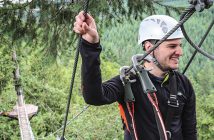As the aerial adventure park industry continues to grow, park owners and operators are seeing a new type of guest. Participants are no longer just adventure junkies—the types who trek off to Queenstown, New Zealand, to jump out of airplanes and bungee jump from bridges. The clientele has become decidedly more mainstream. The question has become, how much should parks hold their hands and reduce risk? Or more precisely: what type of belay system to implement?
How clipped in your guests should be is hotly debated. Many believe that securely clipping in participants from start to finish, and not requiring them to think for themselves, is the best approach. Others resist, declaring that taking all responsibility for safety away from the guest removes much of the thrill from the activity. There’s a financial advantage, too, in making guests an active part of the safety system: the static belays that this involves are the least expensive.
But advances in technology allow aerial parks to create the illusion of risk while greatly reducing it. And that, some argue, is the best of both worlds.
“Safety systems have progressed tremendously in the last five years or so,” says Bahman Azarm, CEO of Outdoor Venture Group, which designs, builds and operates aerial adventure parks and owns Ropes Park Equipment, a distributor of the Bornack smart belay. “When these activities started in Europe 25 years ago, they started with a wide lanyard with double locking carabiners at the end, and you would emphasize to guests to only use one hand because there was much less of a chance of unlocking them both. Many guests just didn’t understand the consequences of doing that. A bee could sting them, or someone could nudge them, and they could fall. There are still a large proportion of parks in Europe using them, and many in the U.S.”
“We try to get the human error part out of it as much as possible,” Azarm says.
Builder/operator Gerhard Komenda, distributor for the Edelrid smart belay, says, “People say safety gear is so expensive, but how do you justify a customer getting hurt, or compare it to how much a lawsuit is going to cost?”
There is no question that using the latest technology and training staff thoroughly can greatly mitigate risk, regardless of the belay system used. But as good as the technology now is, nothing is completely foolproof. Park visitors have proven that by injuring themselves in seemingly unimaginable ways.
Still, it’s important to note how far the industry has come. Mike Holder Sr., one of the pioneers in North American zip lining, founded Historic Banning Mills, Georgia, one of the world’s largest parks, back in the 20th century. At the time, he says, insurance companies watched him “like we were going to kill everybody. They watched us to see what we were doing and if it could be done safely. Now insurance companies bid for our insurance.”
To provide an overview of belay systems, Adventure Park Insider tracked down the folks who distribute and sell the products. Since terminology can vary from brand to brand—particularly over what is a “smart belay” and what is a “continuous belay”—we’ve divided the products by adhering to the definitions below.
Static belay: Has two Y tails or lanyards that attach to the belay cable. The user manually opens and closes the connectors, and is responsible for ensuring one lanyard is always locked on. The system does not have a mechanism to ensure that one of the two is always attached to the belay line—that responsibility remains with the user.
Smart belay: Has two attachments to the belay cable and a mechanism that ensures at least one attachment is locked onto the belay cable at all times. This allows users to switch between elements by moving the attachments, one at a time, from one belay line to the next. This also preserves some of the adventure and participation involved with static belays, but with less risk a guest will go off belay.
Continuous belay: The participant is attached to a belay line at the start of the tour and never disengages until exiting the course. Guests are attached to the belay line by a single lanyard, which attaches to a trolley—or in some cases to a carabiner-like clip—that runs on a continuous cable system. Many of these systems adapt for zip lines and vertical features.





